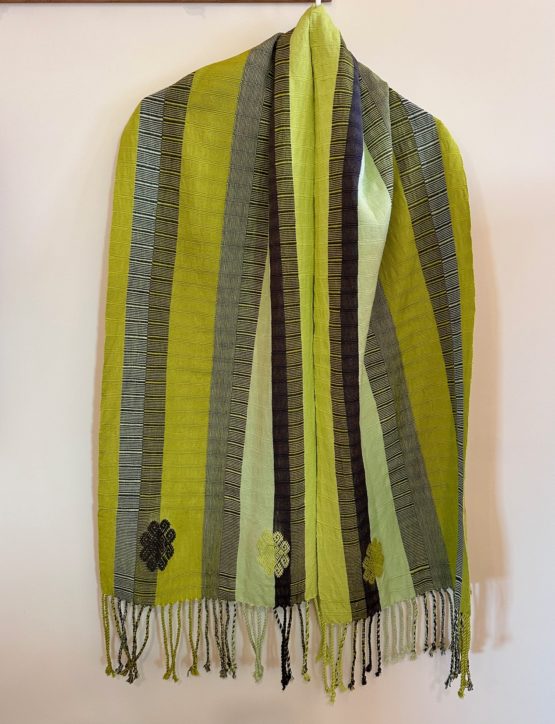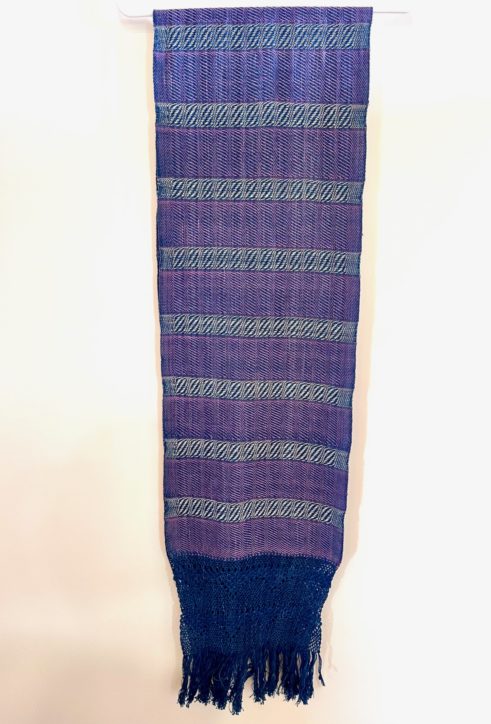Many of us find comfort in the handmade. We know that most handwoven, embroidered, appliqued, and other ornamental elements of cloth are made by women, many of whom live in rural areas that struggle with poverty, lack of access to health care and limited educational facilities. We buy, collect, wear handmade not only for its innate beauty, but because we are supporting women and families. The social justice of textiles is cross-border and cross-politics.
Yet, political boundaries separate tribal groups and families, too. Think of the Maya of Chiapas, Mexico and Guatemala, who were separated by the Usumacinta River post-Mexican Revolution. Think of the Pakistanis and their cousins who live in Gujarat, India, separated after the partition that created the Muslim and Hindu nations.
Textiles know no borders, grew in similar ways on different continents, using the same techniques, explains Yasmine Dabbous, PhD, an anthropologist who is based in Beirut, Lebanon. Founder of Kinship Stories, she delivered the keynote address at the Weave a Real Peace (WARP) Annual Conference that I attended via Zoom on Saturday, June 19, 2021.
Textiles are the human common denominator, creating connections and giving us the capacity to communicate beyond the politics of national borders. Textiles promote cross-cultural exchange and migration. Ancient trade routes expanded our capacity to understand and fuse differences. As human beings, we desire to create or appreciate creativity, and travel has given us the ability to blend different techniques and designs as creators and makers. Across the continents, peoples exchanged fabrics, culture, art, techniques and language.
Visually, we see the similarities of designs: the infinite circle of life, the Eye of God, the butterfly, mountains and rain, the life affirming force of the sun, the power of lightening, the duality of light and dark or man and woman. Common threads point to common interests, dreams, fears and needs. We seek meaning in textiles that share these common motifs even though there was no physical connection between makers from disparate parts of the world.
The symbols of cloth point to fertility and childbirth, abundance, protection, universal hope. The Evil Eye represents fear of the unknown expressed in the embroidered mirrors of India, glass beads of Egypt, amulets in Southeast Asia.
The Social Justice of Textiles now points us to what we value and what we need to pay attention to: handmade beauty of slow fiber or mass produced fast-fashion that results in pollution, cheap prices, subsistance labor in abusive factories. Disposable clothing in a disposable society represents, I believe, deep dissatisfaction that yields multiple marriages, self-indulgences and self-destruction.
Fabric has a lot to teach us. Whether it is embroidery, knitting, sewing, weaving, piecing, dyeing, designing, these are art forms practiced by both women and men. It is a way for individuals and communities to rise out of poverty, to overcome war and refugee experiences. For the individual, the meaningful act of creating can eliminate sadness and depression, is empowering and healing, may resolve conflict, and overcome the ravages of lingering colonialism.
When we purchase clothing to wear, we have a conscious choice to make. Will we invest a bit more to buy something that is created by hand that will directly improve the lives of the makers? Will we choose a low-cost, factory-made garment that will serve us in the short-term? Either way, it is important to be aware of our own reasons and motivations, as well as our own willingness to understand ourselves, others and the world we inhabit.
There are no intellectual property protections for indigenous makers in the international court of law. IP laws cover individuals, not cooperatives or communities. We must also be aware of “knock-offs,” what textile leaders are calling cultural appropriation or cultural plagiarism. This is rampant in the design world, where native symbols of meaning and spirituality are replicated only for the purposes of commercialization and profitability, made by invisible labor hired by factory owners who work under the most oppressive conditions. We call these sweatshops and they follow the international labor market, moving to countries where manufacturing is the most profitable, taking advantage of the lowest hourly wages with no benefits.
One way we can all reassure the continuity of native cultures and fair-market value is to buy directly from artisan makers, and when this is not possible, to purchase directly from representatives who understand and support their endeavors. Please help spread the word!
Some Resources:
Kinship Stories, Yasmine Dabbous, Ph.D.
Weave a Real Peace (WARP)
Spiderwoman’s Children (Thrums)
Weaving for Justice, Christine Eber, Ph.D.
I am offering textiles and jewelry for sale in my Etsy Store. I support artisan makers. If you are interested in making a purchase, please see the Etsy Store, then send me an email norma.schafer@icloud.com When you buy direct from me, I will offer you a 10% discount and a $12 flat rate mailing fee. You may purchase with Zelle, Venmo or PayPal. Thank you very much.

















































WARP Takes a Oaxaca Textile Study Tour with Norma Schafer, Oaxaca Cultural Navigator LLC
Last Saturday, 70 WARP conference-goers divided up and piled into four red vans to go on an all-day natural dye textile and weaving study tour that I organized.
At the Montaño family weavers who make beautiful bags
We left our Oaxaca hotel at 9:30 a.m. and didn’t return until after 7:00 p.m. (and in a rain storm). It takes much longer to move 70 people than it does to lead a small group of three!
Weaver Alfredo Hernandez wearing a wild marigold-cochineal dyed scarf
Of course, I couldn’t be on all four vans at once, so I had great help from dye master Elsa Sanchez Diaz, applied linguist Janet Chavez Santiago, and blogger Shannnon Pixley Sheppard who staffed the other three.
Lunch at Tierra Antigua Restaurant, Teotitlan del Valle
Thanks to them and a schedule that brought us all together for lunch and an end-of-the-day reunion, the day went off without a hiccup.
Program Chair Judy Newland adds cochineal to her indigo hair
We hopscotched all over Teotitlan del Valle and made a detour to Lachigolo to visit weavers I know who work in naturally-dyed wool and cotton.
Lola (Dolores) and Fe (Federico) demonstrate over-dyeing techniques
We got demonstrations of the natural dye process, tapestry loom weaving techniques using the fixed frame, two-harness pedal loom used to make rugs.
In the studio of Galeria Fe y Lola — Federico and Dolores
We saw the flying shuttle, four-harness loom that can make yards of cotton cloth with more intricate patterning depending on the sequencing of the foot pedals. The cloth woven for clothing and home goods.
Preparing warp threads for flying shuttle loom
Most importantly, we had the opportunity to meet each family, understand how they work in collaboration and in family units, and see how they are inspired to make very distinctive products from each other.
Francisco Martinez takes pericone — wild marigold — from dye vat
Every family has their own dye recipes and design adaptations. Some are doing very pioneering work, combining wool and agave plant fiber.
Aztecs used dyed chicken feathers to add color to white cotton – revitalized now
Some are doing very fine wall tapestries with 17 warp threads per inch. It is wonderful to see the range and variety of creativity and inspiration.
Alfredo’s son prepares bobbins for the loom — a family endeavor
Alfredo collaborates with Ayutla embroiderer Anacleta Juarez
Alfredo Hernandez weaves the natural manta with the finest cotton threads. Then embroiderer Anacleta Juarez creates the most detailed, intricate finely stitched work I’ve ever seen.
Wild marigold fixes with a local plant called marush
On day one, cultural anthropologist Marta Turok Wallace talked about the importance of collaboration to further innovation that will sustain tradition.
A shady respite along the way — Judy, Ana Paula, Gail, Patrice
Isaac and his mom, Maria de Lourdes, wash the wool before it goes into the dye bath
Wool tapestries with natural dyes, with Francisco Martinez
We gathered at the end of the day at the home workshop and studio of Porfirio Gutierrez and his family for traditional hot chocolate, bread, mezcal and a demonstration. Big thanks, Porfirio, for your hospitality to welcome 70 people!
Cochineal grows on prickly pear cactus paddles behind Porfirio Gutierrez
The family is working in wool dyed with natural plant materials and cochineal. They are innovating with rug designs that resemble a petate that incorporates plant fibers like jute and ixtle.
Two dye masters huddle: Elsa Sanchez Diaz and Juana Gutierrez, Porfirio’s sister
Wrapping up a petate design rug to go — a combo of jute and indigo!
In the courtyard, Francisco and Patrice talk about possibilities
Behind a wall, a flying shuttle loom workshop awaits us
Shopping for napkins and tablecloths made on the flying shuttle loom
Sales assistant in training!
Juana and her 6 months-old granddaughter
Cochineal dyed cotton out to dry on the line
Almost every weaver here knows how to prepare a demonstration using natural dyes. Many have the materials on hand to show visitors. Yet, it takes half the time to prepare wool using aniline dyes as it does to prepare natural dyes. The dye materials are 10 times more expensive.
Cochineal and indigo dye wool
Some say that about 10 to 15 Teotitlan del Valle families may actually use natural dyes in their work. (I don’t know the exact number.) If this is important to you, you may want to join one of our one-day study tours to take you to them. The price will be higher for these beauties, but there is a distinctive difference in color palette and quality.
On the van, WARP conference Oaxaca
WARP president Cindy Lair with Montaño family
The little red vans that could! Gracias, Silvia and Cesar.
One more post about the WARP Conference in Oaxaca, 2017, and the walking tour of the historic center that Janet and I led last Sunday. We explored the nooks and crannies, found paper earring for Louise, good strong coffee for Diane. In two outstanding galleries, we had talks from owners and managers about quality differences in materials, dyes, and hand-looming.
Tying pom poms on purse zippers, Montaño family
Thanks to WARP for coming to Oaxaca, and thanks to you for reading.
Like this:
10 Comments
Posted in Cultural Commentary, Teotitlan del Valle, Textiles, Tapestries & Weaving, Travel & Tourism, Workshops and Retreats
Tagged Mexico, natural dyes, Oaxaca, textile tour, WARP, weaving